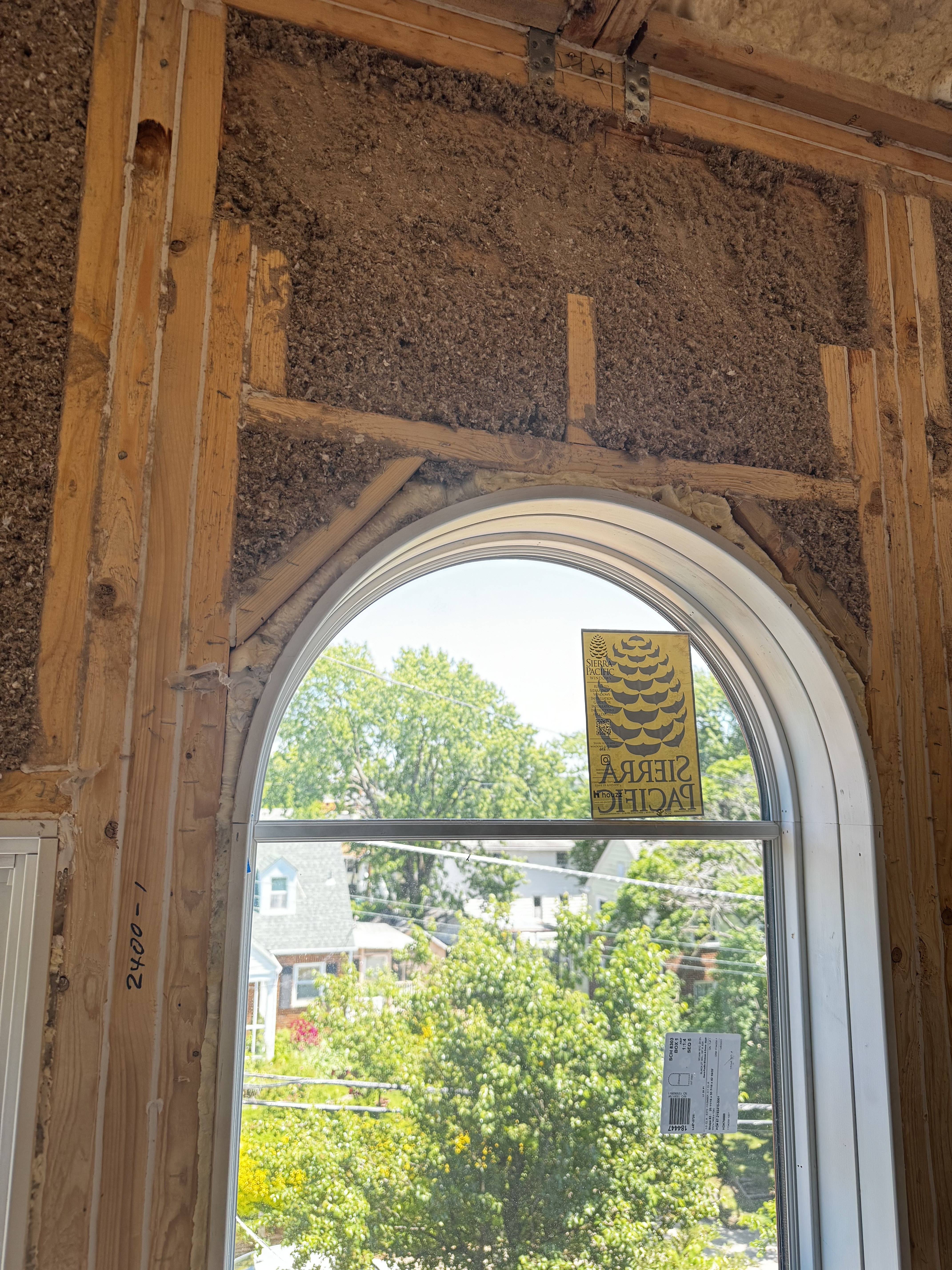
Net-Zero Restoration: A Victorian Home Rebuilt with SANCTUARY Cellulose Insulation
The historic suburbs of Prince George’s County, Maryland, about six miles outside of Washington, D.C., were once brimming with elegant Victorians. Originating in the late 19th century, these homes were easy to spot because of their intricate detailing, monumental front porches and playful, asymmetrical floor plans. With time, the neighborhood has taken on a new design identity: Now lined with mid-century bungalows and Craftsman-style homes, it is only sporadically dotted with reminders of a bygone era.
One such residence is Queen of Zero, a custom, Queen Anne Victorian-style home being rebuilt in the wake of a devastating house fire in 2020. The original homeowner, a longtime Maryland resident, was faced with a choice: out with the old or out with the new. Instead of opting to build a modern-day home on top of the ashes, the owner committed to preserving the original home’s historical dignity and charm with an eco renovation. If this wasn’t enough of a challenge, the owner insisted that the home achieve net-zero performance.
Challenge accepted, thanks to a collaborative effort by Greenfiber®, the Journal of Light Construction and Symbi Homes.
Nicole Tysvaer, CEO of Symbi Homes and director of sustainability for Queen of Zero, recognizes that honoring the original home’s Victorian design while achieving optimal energy efficiency is a tough task. Acing a project of this magnitude takes both sustainable and high-performing products, even down to the insulation.
Now, let’s see what made this transformation possible.
The Challenge of Restoring a Victorian Home and Making It Net Zero
The Initial State: A Historical Home Devastated by Fire

We often forget that our homes are not just a soft place to land, but a reflection of history. Just strolling through the Prince George’s County suburbs, for example, can take you back 150 years, when Victorian-style homes were freshly in vogue.
Originating from English architects around 1880, the style was warmly welcomed by American homeowners, who were newly wealthy in a booming economy. Since then, original Victorians have faced an inevitable fate: Fire damage and the need for major renovations have depleted their numbers across the country. Once common sights are now rare treasures. Even though Queen of Zero will not be a replica of the original, the homeowner is dedicated to holding on to what once was.
Balancing Historical Design with Modern Sustainable Practices
As with any construction endeavor, re-creating a Victorian can present challenges. Doing so with optimal sustainability and functionality in mind adds another complicated, but extremely worthwhile, layer to the puzzle.
To achieve net zero — meaning the building produces as much energy as it consumes each year — Symbi Homes prioritized energy efficiency from the inside out, starting with innovative building materials.
Keep reading to learn how SANCTUARY® by Greenfiber helped preserve the home’s storied history while keeping an eye toward the future.
The Decision to Use SANCTUARY Insulation for a Net-Zero Home Renovation
The Sustainability and Performance Benefits of SANCTUARY Cellulose Insulation
Although it’s typically out of sight, insulation should not be out of mind. Ultimately, Tysvaer’s choice to install cellulose insulation in Queen of Zero came down to two equally weighted aspects: high performance and sustainability. Let’s take a closer look at the many benefits of installing SANCTUARY.
SANCTUARY Insulation Is Made from Recycled Materials
Even though SANCTUARY is distinctly beige, its ultimate impact is green. Cellulose insulation, unlike other commonly installed building materials, is made from up to 85% recycled consumer paper products such as paper and cardboard. Each year, this pulls about 277,000 tons of paper from landfills, not to mention the subsequent manufacturing process is about 13 times more energy efficient than other types of traditional insulation.1
SANCTUARY Insulation’s High R-Value Promotes Energy Efficiency
We know that about 20% of greenhouse gasses produced in the United States originate from heating, cooling and powering households. So, how can we reduce our footprint without compromising on the things we love about our home?
High-quality insulation is the golden ticket.
SANCTUARY is renowned for its high density and R-value. This means it creates a dense barrier that limits heat transfer between the outside and inside of the home. Minimizing this airflow requires less electricity for heating in the winter and for cooling in the summer.
Tax Incentives for Energy-Efficient Renovations with SANCTUARY
While prioritizing energy efficiency is one of the best ways to reduce a home’s carbon footprint, it often comes down to affordability. Fortunately, the Inflation Reduction Act of 2022, which is a part of the United States’ effort to reach net-zero emissions by 2050, funds nearly $369 billion worth of renewable energy equipment. The law offers several cost-saving tax incentives for those who prioritize energy efficiency.
Superior Sound Control Compared to Other Insulation Types
Many assume that all insulation gets the job done in terms of soundproofing, but this is far from true. For example, cellulose fibers control sound as well as, or in some cases better than, 4-inch sound-control fiberglass batts. Cellulose insulation has even been shown to outperform spray foams such as polyurethane.
Even Tysvaer was surprised to hear the results: “The sound attenuation surprised me,” she said. “After we installed [SANCTUARY] into the other project, I went in afterward and was like, ‘It is so quiet in here.’”
SANCTUARY is a much healthier product to install than other types of insulation. We don’t have to wait to enter the home for 24 hours. We can walk in and touch it right after we install it. Nicole Tysvaer, CEO of Symbi Homes and director of sustainability for Queen of Zero
On top of these benefits, Tysvaer was impressed by the ease of installing SANCTUARY, especially when it came to air quality: “SANCTUARY is a much healthier product to install than other types of insulation,” she said. “We don’t have to wait to enter the home for 24 hours. We can walk in and touch it right after we install it.”
Overcoming Hesitations About New Insulation Technologies
We tend to like what we know, even when there might be something better out there. While Symbi Homes ultimately chose SANCTUARY for their insulation product, Tysvaer understands why builders who have never used a certain product might be hesitant to try it for the first time.
“Innovation can be viewed as a risk that can cost a lot of money,” she said. I like to bring increased knowledge and awareness to new products or innovations so that they don’t seem so risky to the average builder. This is why I like to partner with companies such as Greenfiber because they have a proven technology, but they haven’t gotten to mass adoption yet.”
So, take Tysvaer’s word for it: The risk is often worth the reward.
Preparation and Installation Process for SANCTUARY Insulation
Installing SANCTUARY in Queen of Zero for Net-Zero Efficiency
When Queen of Zero is finally complete, onlookers might initially notice its sunburst panels, high-peaked gables and eclectic colors. But what they won’t see is what lives within the separation walls and the basement ceiling: insulation that makes the house a comfortable home.
There are many different ways to install SANCTUARY, depending on the insulation location and the project’s specific goals. In Queen of Zero, installers used dense packing to fill separation walls and basement ceilings and a spray-applied technique for other walls. This leaves Queen capable of reducing sound power and heating and cooling costs — boosting everyday comfort for the homeowner.
Collaboration with Trusted Insulation Experts
Homeowners are able to install SANCTUARY themselves, but we highly recommend using professional installers for a safe and efficient job. Greenfiber Trusted Installers are specially trained to install SANCTUARY. Plus, they are equipped to answer all of your questions about our products and services, along with tax incentives and local rebates that could help you save some cash.
Find local professionals in your area trained to install SANCTUARY.
To ensure that SANCTUARY was installed properly in Queen of Zero, Tysvaer worked with Southland Insulators, a trusted, top-notch insulation company, and made sure all the specifications were vetted by them.
Tips for Achieving Net Zero for Your Building Project
Aspiring to achieve net zero is not a simple task but one that represents a commitment to a greener world. It’s easy to get too deep into the weeds from the jump, so we recommend starting with one project — even one product — at a time. When in doubt, focus on the products that align with your goals.
So, when the time comes to install a sustainable, reliable and high-performing insulation product on your path to net zero, find a SANCTUARY Trusted Installer who can help put your aspirations within reach.
1 Comparison based on an R-30 value at one square foot coverage area. This comparison includes the production and energy used in the insulation manufacturing process. Based on Sustainability Impact Index - Prepared by Principal Partners.
Hero photo credited to Romero Architects (design) and Unik Creative Studio (3D Rendering).
- Category: Case Studies, Sustainability

